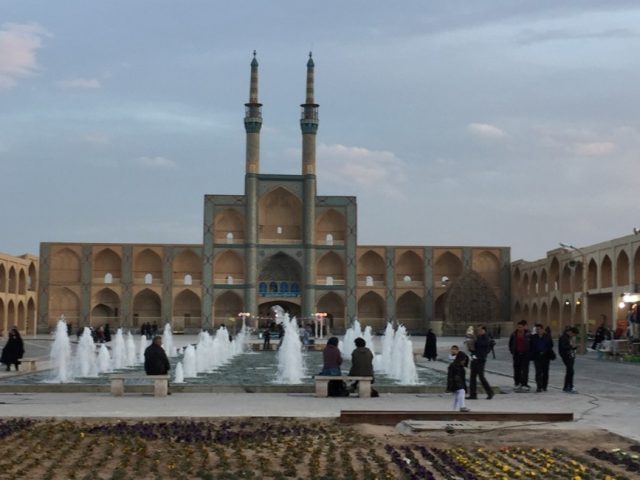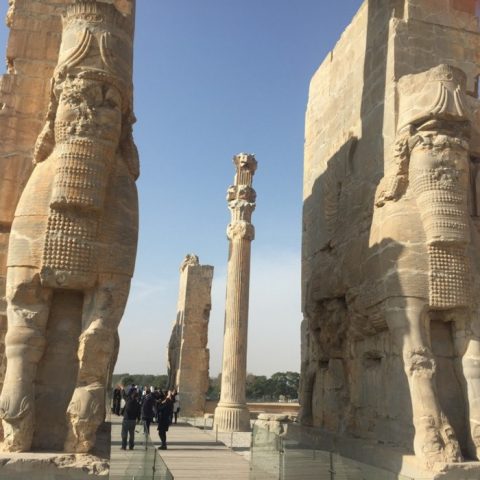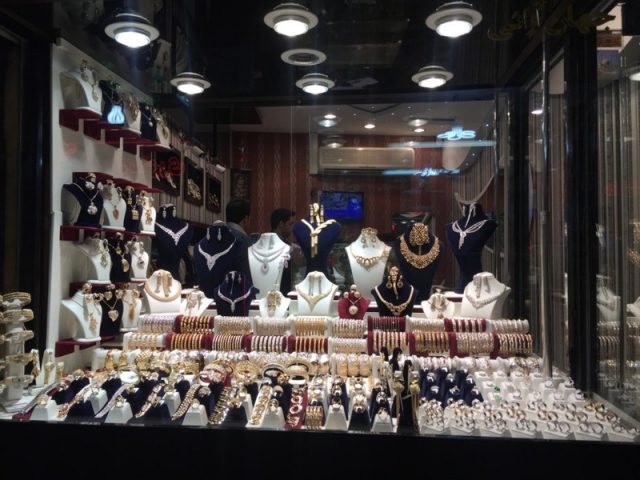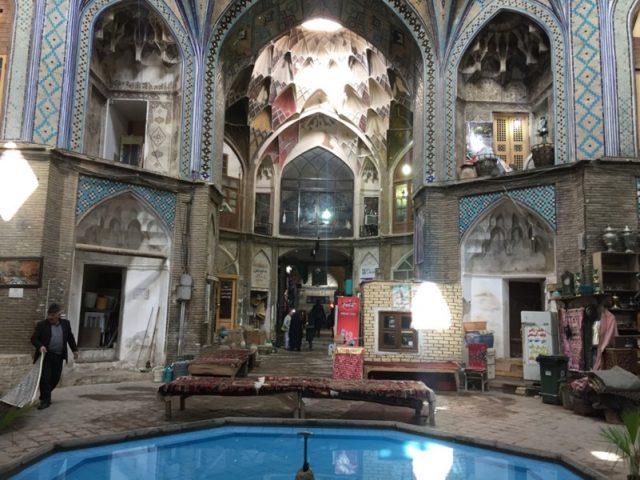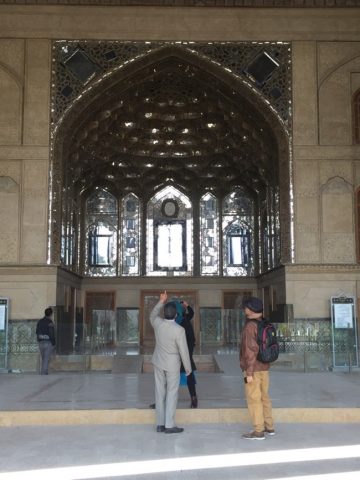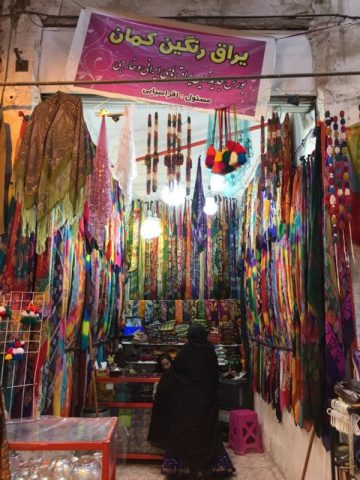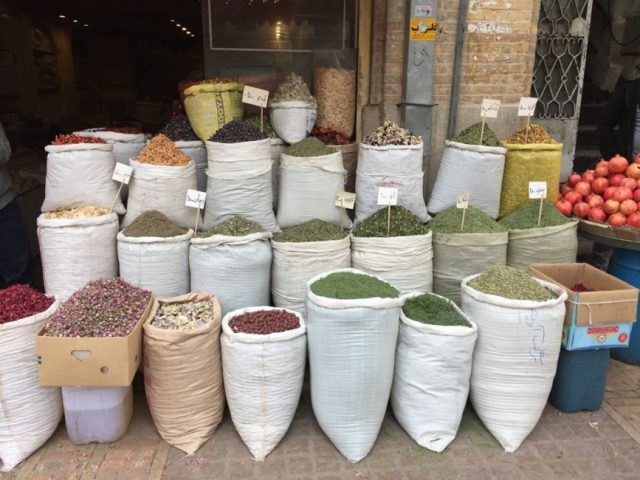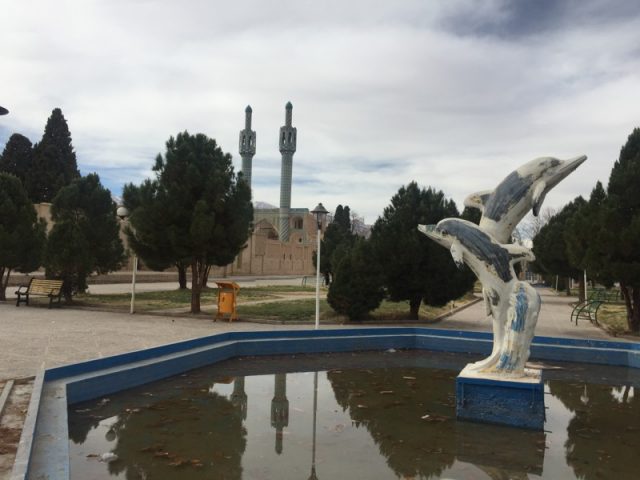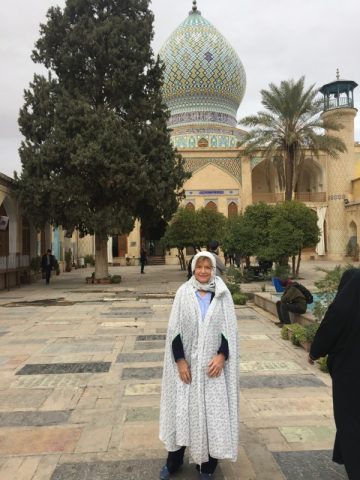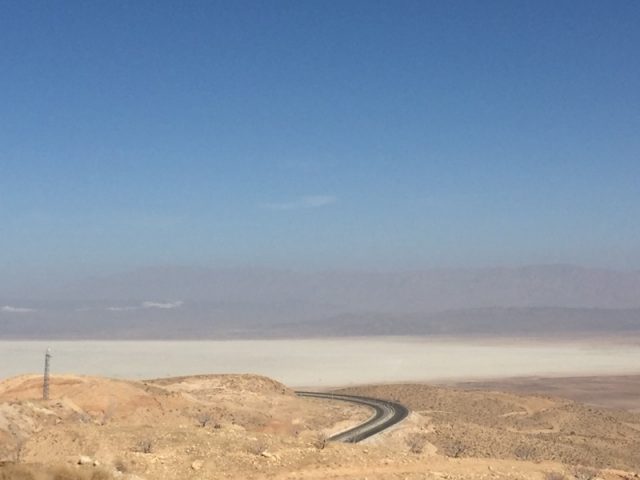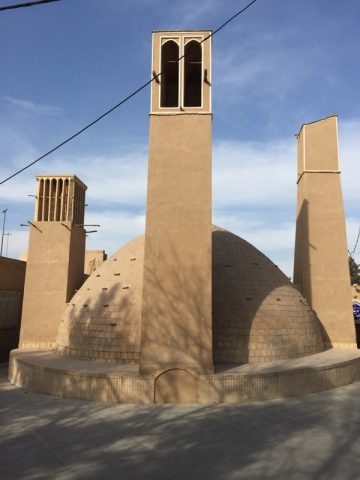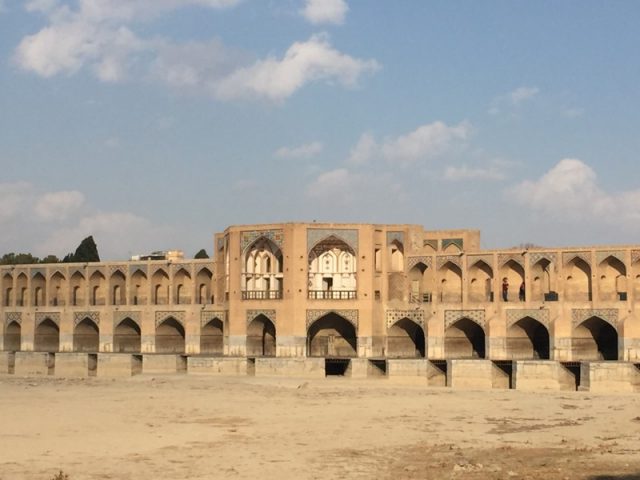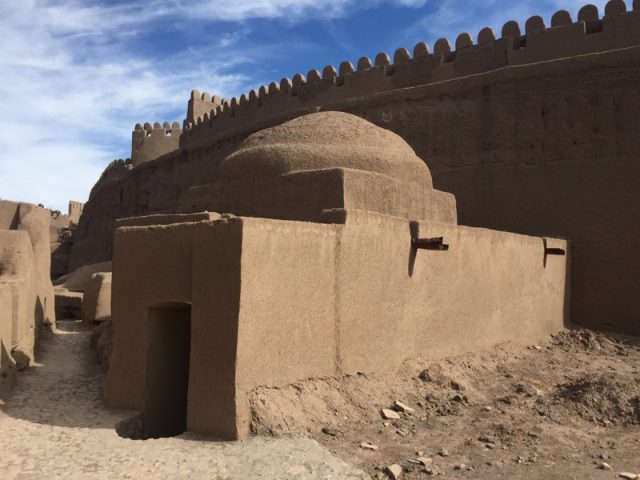2,500 Kilometers in twelve days was quite a trip to make. The route: Shiraz – Kerman – Yazd – Isfahan – Kashan – Teheran. As I have already traveled to many countries, I considered myself to be open-minded for this journey. I felt all the more prepared because I have visited Iran’s neighbors Turkey and Pakistan.
After my trip, many people asked me about my most significant experience. In reflection, it is my realization that I had and probably have prejudices. The most important preconception: Iran is a developing and unprosperous country. I now witnessed that Iran is a wealthy country – and this despite the sanction it has suffered from for decades. The advantage of the sanctions is that Iran has become more or less self-sufficient, developing its products with an economy based on its own power and skills. One can see this everywhere. Additionally, its population has more than doubled in the last fifty years and reaches now nearly 80 million people, most of them under the age of thirty.
At first sight, Iran’s wealth is evident in its buildings, streets, products, services and its people. The streets I saw were perfect. There was a tremendous amount of construction activity taking place. As earthquakes endanger Iran, all buildings have a steel frame, and you see unfinished buildings with the prospect of being finished soon all around your travels through the Iran, especially along the Highways.
The wealth of Iran’s population is present in the faces of its people: they are friendly, open-minded and interested. One of the main reasons for that is the fact that around eighty percent of the youth in Iran will pass a twelve-year school system. Many of them will also go on to study in university afterward. Meanwhile, the percentage of female Iranian students is sixty percent. 15% of the national budget goes to education. There is lots of evidence for this in everyday life. One example is the common knowledge of English. We even met many young people who spoke fluent German, many of whom had studied in Germany. The Iranians’ thirst for knowledge was also evident by individuals’ coming to talk to us at every possible opportunity. They wanted to know from where we came, how we liked Iran, where we had already been, and were planning to go. Most of them wanted to know more about precisely from which part of Germany we came. During the times “after the revolution,” as the period after the Shah is usually called – that is, after 1979 – many universities were established throughout the country, most of them private.
Unemployment in Iran is still high. According to our guide, it ranges between 20 and 23%, and particularly young people are unemployed. Many academicians thus work in inadequate professions such as tourism or other service providing industries. The vast majority of Iranians have a roof over their heads, running water, and can heat their homes in cold weather. However, there are also homeless people and people addicted to drugs which are isolated from society and suffer a great deal. But as a rule, most Iranians are charitable and help their fellow citizens. Even the more than two million refugees – mainly from Afghanistan, but also from Pakistan – are thus able to get by. Despite being illegal and fearing possible deportation at any moment refugees are tolerated, and many of them live with their whole families in Iran. Most of the men find employment in positions providing cheap labor such as the building industry.
Another example of the country’s affluence is evident firsthand in the condition of the roads, cities, clothing, vehicles, means of transportation, and the treatment of the landscape. In all of these areas, I found higher quantity and quality than I had expected. I, therefore, had to ask myself from where my image of Iran came, and I realized that I hardly had consistent information before I started off on this trip. In my opinion it would be desirable for us to receive more factual and impartial information of this beautiful country.
Another prejudice I had was the assumption that on my tour, I might see a landscape similar to that already familiar to me. But this was not the case. Although I had previously been to very many countries, the Iranian journey was very different from anything that I had been able to imagine. We were always at an altitude of at least 1,500 m, a drastically different bodily feeling for people like me who usually live at 150 m. As a result, I initially felt weaker and more fatigued than usual, and also a bit dizzy. It took a while for me to realize what the reason was. The highest altitude we reached was 1,900 m.
Our entire route – we also visited a few smaller towns, but I won’t mention them here – went over expressways that were relatively straight despite the differences in altitude, as the landscape was flat. To the right and the left of our road, there were mainly steppes, even desert, altering with agricultural areas of differing fertility. Sometimes, the roads also went through small desert areas. At varying distances, there were high, occasionally snow-covered mountain ranges. Some of these mountains grant the populace an income from utilizing their resources: travertine, marble, bright and dark limestone, and loam. Adjunct to this, there was handiwork and industry: porcelain and tiles, trade in marble and construction materials, arts and crafts. In more remote areas, there are impressive, partly inter-urban clay buildings, some of which are still inhabited.
We saw many UNESCO World Heritage sites. Iran has been very active in this program, and rightly so. At some point, I stopped counting the number of mosques we visited. Iran is a God-fearing country. However, the people love God more than they fear Him and this is a big difference. The 114 Koran’s suras received by Mohammed from God through His messenger Gabriel are thus mainly aimed at moving humankind to perform good and empathetic deeds. I was able to read such suras everywhere, as some of them are also in English. In the mosques, one can find them usually written in both Arab and Persian script, as a part of the building itself.
Now, what is the difference between the Shiites, who are the majority of the believers in Iran, and the Sunnites? The fundamental difference is the acknowledgment of who exactly is the successor of the prophet Mohammed. For the Shiites, it is Ali, Mohammed’s cousin and son-in-law. For the Sunnites, it is Abu Bakr, Mohammed’s father-in-law. I found the name Ali immortalized in all Shiite mosques, and when presented in a particular way, it even looks like a swastika – this as information to particularly sensitive Germans who might otherwise see something else in it. I saw several mosques in which the names Ali, Allah, and Mohammed were distributed in equal quantities across large surfaces – in Persian, of course.
The bazaars of Iran are a special and unique experience. They serve the primary supply of the urban population, even in cities where there are already big shopping centers – also in the inner cities. You can buy every imaginable kind of merchandise in the bazaars which partly run for kilometers on end. I took numerous photos of typical booths where, day in and day out, young and old men and women offer their limited range of merchandise and find their customers, very few of whom are tourists. I remember being surprised at noticing about fifty jewelry booths, most of them right next to each other, in the bazaars of Isfahan or Yazd. Unimaginable beautiful artistry and fantasy completely based on tradition make a spectrum of offers possible. I was never able to find any offers departing from this tradition. One can thus say with certainty that Iranian women wear traditional adornments – the more they wear, the more affluent they are. However, this is certainly not seen on the street.
Many asked me about my experience as a woman. Well, I always had to cover my head in public. I also had to avoid wearing clothing that placed emphasis on my body. More than half of Iranian women cover themselves with a black veil (hijab) reaching down to their ankles. As a rule, the black veil mostly covers black clothing. One should know that the majority of these women do this because they want to do so. It is a gesture of devotion based on religion, culture and belief. Traditionally, the entire body is supposed to remain covered, except for their faces, hands, and feet including ankles. However, there are now also women who wear bright-colored trousers beneath their veils. So you can see, in part, very youthful fashions, often knee-long coats in the wintertime, already with narrow waists with belts. Close-fitting trousers are also frequently in fashion. I saw boots and, in the evening, even nylon stockings shimmering between boots and skirts – but never in the street. Women can wear daring, secular clothing amongst each other, or in the most intimate family circle. In the shops you see a plentitude of beautiful clothing in which women can admire one another. Iranian women are not supposed to display their bodies – and when I imagine these many beautiful women of Iran without veils I can understand that they are an enormous temptation to men.
Speaking of seduction: I was never bothered by a man or woman – when I smiled people usually smiled back very warm-heartedly. Altogether, one can sense strong connections between women. I, as a novice veil-bearer, felt accepted in the midst of the women and belonged to them. This special bond between women may also be a result of girls’ and boys’ attending separate schools, and not studying together until university. In general, I would like to point out the gracious character of the Iranian people whom I met. They wanted to help and to support me as a foreigner. They were friendly and charming. They were open and seeking communication.
One area I noticed a different demeanor was amongst the wait staff. This may be related to the background of Iran’s not very well-developed service culture which still needs further training. Even in five-star hotels, the majority of the restaurant staff are of the opinion that the guests should serve themselves and that they are only there to guide and to guard this process – particularly at breakfast. Several times, the breakfast staff members chattered animatedly amongst each other throughout our breakfast – often with their backs to the guests – and only went into action when it was time to clear the tables. As a rule, big carts still transport tableware – and may even take precedence over guests in the sense that guests must make way for them. Interestingly I just read that the first restaurant and hotel textbook will be compiled, in collaboration with France, and the French and Iran governments signed a number of agreements to cooperate, one of which includes the training of Iranian hotel managers and staff by French experts. Ecole Hotelier de Lausanne has signed a Memorandum of Understanding to open a hotel school in Isfahan.
The crime rate in Iran is low, and tourists can feel quite safe from pickpockets and the like. The danger of terrorism has also banished, as Iran has strongly fortified its frontiers over the last years – the border of Afghanistan even partly with a wall to stop exportation of drugs, terrorism, and illegal migration. Nevertheless, I heard that Iran has a problem with drugs – all the more since cheap drugs produced in laboratories have been made available on the market. Furthermore, smoking opium is still very common, especially near the Afghan border, and altogether, Iran is directly on the road by which drug smuggling occurs to Turkey and Europe.
Due to its geography and its history, Iran is a country comprised of large cities. According to the census of 2011, Tehran had a population of 7.8 million; including all of the outskirts, it numbers 16 million inhabitants. The other cities on our route had populations (before the slash according to the census of October 24, 2011, and after the slash, projections dating from September 2016). Kashan 254,000/272,000; Kerman 515,000/534,000; Yazd 432,000/486,000; and Isfahan 1.6/1.76 million. Urbanization is galloping. High-rises are going up everywhere – on top of steel scaffolding due to the prevalence of earthquakes. Construction work occurs more steadily, and in many places, incomplete high-rises are standing at the roadsides, looking like they will soon be complete. The reason for this has to do with population growth: in the 1960’s, there were fewer than 30 million Iranians; there are now more than 80 million, whereby the largest group is people between 25 and 35. This statistic will transform Iran enormously during the coming decades, especially since many young people are well educated.
National pride, love of the fatherland, and love of tradition are great, and thus Iran has much that connects its people to each other. Many Persians are increasingly conscious of their culture spanning millenniums, starting long before Islamification. Particularly the city of Persepolis, established in the 6th century B.C. and the richest city in the world at that time, bears testimony to the great tradition of the Persian empire. Even at this period, a monotheistic religion was practiced. The Achaemenides followed a religion of ethical principles. Persepolis – Parsseh in Old Persian – from which the name Persia derives -, was destroyed by Alexander the Great, who set it on fire after plundering it. More than 3,000 camels and 20,000 mules were needed to cart away its treasures. The last Shah reconnected to this tradition, declaring Persepolis to be the cradle of the Persian nation. Nowadays Persepolis is no longer an identity-establishing memorial of the state, as it has nothing to do with Islam. Many Iranians, however, still see it as a place of identification.
If you ask me about my opinion concerning the future of this beautiful country I see one of the main obstacles in the suppression of women. No woman wants to wear what she is commanded to wear – especially not today, and not among young people. I think that this will have to change to give women the feeling of being esteemed. Furthermore, women do not have equal rights. For instance, a woman inherits only one-eighth as much as her brothers (which some families circumvent by distributing the property before death). In the event of divorce, the children are given to the men, so that many women do not file for divorce despite being beaten or otherwise oppressed. Here, too, I have heard that changes have occurred, as the young generation carries out divorces by peaceful agreement. Again as women, at the same time, now comprise 60 percent of the students, further changes will have to be made to fulfill their needs in the long run.
Neither are equal rights for other religions granted. No Muslim may marry a non-Muslim who refuses to convert to Islam. Any child of a Muslim is automatically considered a Muslim. Non-Muslims face exclusion from many positions of leadership, both in the Army and in civil services. This order inevitably results in the creation of second-class citizens, contrary to the natural needs, especially of many young People.
Iran is not a democracy, but a country ruled by religious leaders. The merging of religion and politics is problematic. Some people in Iran wish for a separation such as that striven for by the first Shah back in the 1930’s following the example of Atatürk. After taking power in 1926, Reza Shah Pahlavi introduced a unified legal system, rescinded special jurisdiction for foreigners, and abolished the Sharia system. In 1936, he decreed the abolition of compulsory veiling the chador, and propagated, like his son Mohammed Reza Pahlavi, the necessity of the separation of religion and state. Whether this separation will take place, depends decisively on the will of the religious leaders – but also on the activity of civil society, which is not very strong at the moment. I asked several people whether they would consider political action, and each time it was vehemently rejected. I then understood more and more that to become active in politics, one would have to embark on a career within the religious structures – and of course, secularly oriented Iranian citizens don’t want to do this; in fact, due to their lack of religious zeal, they cannot. Alternative political structures neither exist now nor are they currently allowed. Also, the majority of people living in rural areas and small cities and many others love to live with their religious rules. This is a fact and “the West” has to accept this and is not allowed to ignore it – by the danger of war.
“We Iranians always find a solution,” one of my new acquaintances said. “We are intelligent and inventive.” I can only agree with this, and thus the people of Iran will surely find ways to assert their rights and the fulfillment of their needs by peaceful means. All those with whom I spoke assumed that this would be a very lengthy process and nobody desired development or progress by violence. For the older generation in Iran, love of the fatherland is more important than the love of oneself. The country has suffered too much for this to be otherwise. Many promising young men died in the war with Iraq (1980-88). Their portraits are on display in the city’s streets. As the young generation, on the other hand, is thinking more of itself and its advancement this will determine the future of the country. At the same time, the vast majority of the Iranians – as is the case with most people all over the world – want peace, to be able to live for their families, their work, and their creativity.
All of my discussion partners informed me that Iran from the very beginning had the intention to use the atomic energy for peaceful means and assured this all along. It was Shah Reza Pahlavi who decided to set up a research program and who did not accept that the United States tried to prevent it. Why should Iran not have the right to develop nuclear weapons when the US supported its neighbor Pakistan in doing so? Now more than ever it should be the duty of our world family to defend the people of Iran against any attacks of foreign powers. The kind-hearted, sacrificing people of Iran have suffered many years of war and after that many years of sanctions. Iran has the right to flourish and to continue on its way to the peace which it is seeking and should not suffer any further harm. What we need to do in order to find the peace the world needs is to listen to one another. As one of my Iranian friends said: “The reality of my country has continuously been ignored… I was born and grew up in this culture and religion. And I know it well enough. And I respect all of its kind face with deep understanding for all I don’t accept.”



